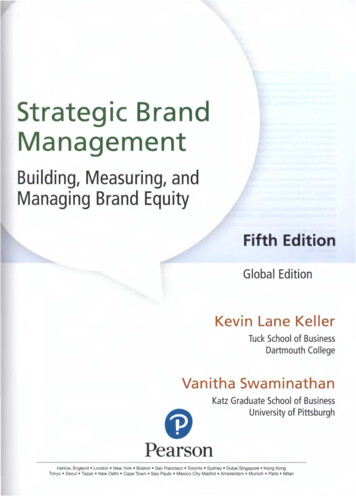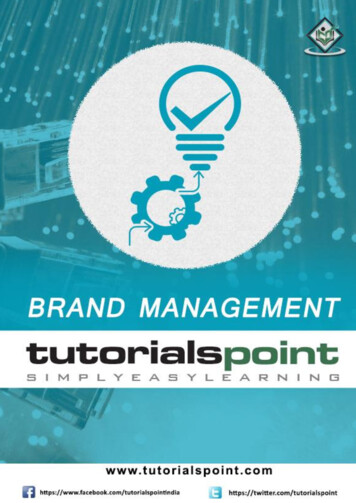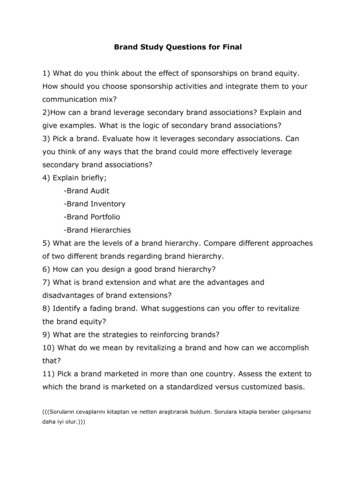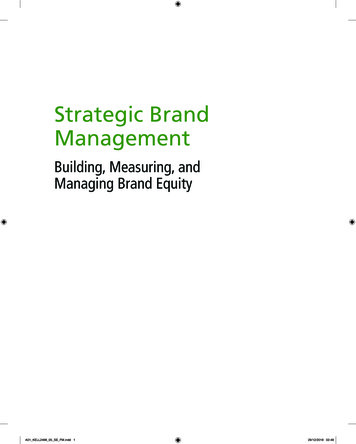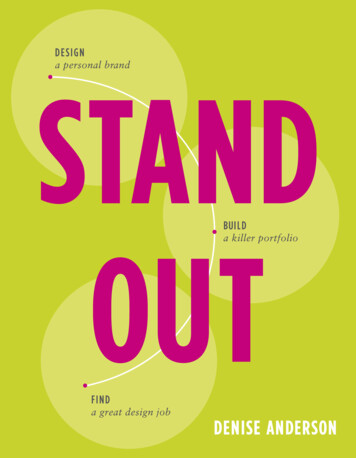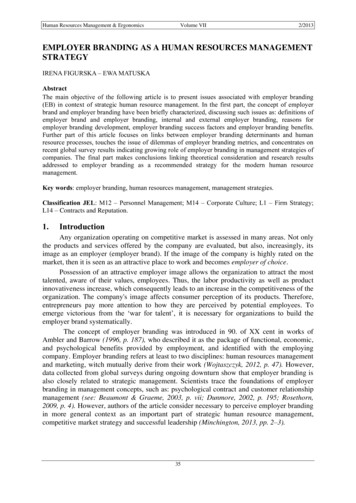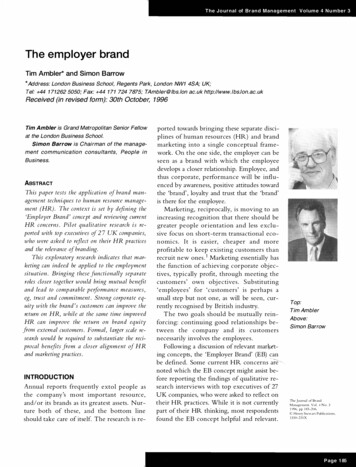
Transcription
T h e J o ur n a l of B r a n d M a n a g e m e n t V o l u m e 4 N u m be r 3Th e employer brandTim Ambl er* and Si mon Barrow* Address:London Business School, Regents Park, London NW1 4SA; UK;Tel: 44 1 71262 5050; Fax: 44 1 7 1 724 7875; TAmbler @ lbs. lon ac. uk http://www. lbs.lon. ac. ukReceived (in revised form): 30th October, 1 996Tim A mbler is Grand Metropolitan Senior Fellowat the London Business School.Simon Barrow is Chairman of the manage ment communica tion consulta n ts, People inBusiness.ABSTRACTTh is paper tests the app lication oj b ra n d man agement techniques to h uman resource manage ment (HR). The con text is set by defining the'Employer Brand' concept and reviewing currentHR concerns. Pilot q u a litative research is re ported with top executives oj 2 7 UK companies,who were asked to reflect on their HR practicesand the relevance oj branding.Th is explora tory research indica tes tha t mar keting can indeed be applied to the emp loymentsitua tion. Bringing these Ju nctiona lly sep a ra teroles closer together wou ld bring m u tu a l benefitand lea d to comp a ra b le peiformance m eas u res,eg, trust a n d commitmen t. Strong corpora te eq uity with the bra nd's customers can improve thereturn on HR, while a t the same time improvedHR ca n imp rove the ret u rn on b ra n d eq u i tyfrom external customers. Formal, larger scale re search would be required to substa n tiate the reci proca l benifi ts from a closer a lign m e n t oj HRand marketing practices .INTRODUCTIONAnnual rep orts frequently extol p e ople asthe comp any's most imp ortant res ource,and/or its brands as its greatest assets . Nur ture both of these, and the bottom lineshould take care of itself. The research is re-ported towards bringing these separate disci plines of human resources (HR) and brandmarketing into a single conceptual frame work. On the one side, the employer can beseen as a brand with which the employeedevelops a closer relationship. Employee, andthus corporate, performance will be influ enced by awareness, positive attitudes towardthe 'brand' , loyalty and trust that the 'brand'is there for the employee.Marketing, reciprocally, is moving to anincreasing recognition that there should begreater p e ople o r ientation and less exclu sive focus on short-term transactional eco nomi c s . I t is easier, cheaper and moreprofitable to keep existing customers thanrecruit new ones . ! Marketing essentially hasthe function of achieving corporate obj ec tives, typically profit, through meeting thecustomers ' own obj e c tive s . Substituting' employe e s ' for ' customers' is p e rhaps asmall step but not one, as will be seen, cur rently recognised by British industry.The two goals should b e mutually rein forcing: c ontinuing good relationships be twe en the c omp any and its customersnecessarily involves the employees.Following a discussion of relevant mar t ing concepts , the 'Employer Brand' (EB) canbe defined. Some current HR concerns are" "noted which the EB concept might assist be fore reporting the findings of qualitative re search interviews with top executives of 27UK companies, who were asked to reflect ontheir HR practices. While it is not currentlypart of their HR thinking, most respondentsfound the EB concept helpful and relevant .Top:Tim AmblerAbove:Simon BarrowThe Journal of BrandManagement. Vol. .j. N o . 31 IJ96. pp 1 85-206. Henry Stt'wart Publications.1 3 50-23 1 XP a g e 1 85
The e m p l oyer brandFigure 1 Linkbetween quality ofemployees and(Best people\quality ofproduct/serviceBest shopsBest appl icantsBest wordof mouthIn the words of one leading retailer amongthe respondents, ' if we have the best shops,with the best people, then we have the bestword of mouth and receive the best applica tions and then we will have the best shops' .Figure 1 , captures the virtuous circle we areseeking.The paper c oncludes with prop osals forfurther research to substantiate the benefits,and identify the disadvantages , from a closerintegration of marketing and HR thinkingand practices . I t is expected that there willbe considerable variation in the optimal mixbetween industries and companies. The re search needs to show not j ust the generalpicture but how c ompanies can select themix of HR and brand disciplines most ap propriate to their circumstances.DEFI N I NG THE E M P LOYER B RANDBerry defined relationship marketing as ' at tracting, maintaining and - in multi-ser vice organisations - enhancing customerrelationships' . Kotler2 shifted from his tradi tional microeconomic orientation to seeingthe marketplace as a 'network of value-ladenrelationships' .Kotler and Armstrong3 see relationshipmarketing as reflecting the goal to deliverlong-term value to customers, and the keymeasure of succ ess as long-term customerPage 1 86Jsatisfaction. The importance of supplier andor customer relationships increases as a func tion of profit margins and the number ofcustomers . A myriad of buyers in a lowmargin business such as a supermarketwould not make for partnership in the sensethat McKinsey has with its clients . The EBconcept has most application in high val ued-added, service businesses: the higherthe salaries and the fewer the number ofemployees, the more each employee rela tionship with the employer matters.Relationship marketing marks a shift, inprinciple, away from exclusive short-termeconomic concern with immediate transac tions toward long-term building of brandequity which Ambler4 has expressed in rela tional terms . In practice, there is constanttension between short-term and long-termconsiderations . Feldwick s has questionedwhether the brand equity concept is neededat all. He is right that the literature is con fused. He is also right that the value of anasset should be distinguished from the assetitself. Thus if, for the moment, a neutralterm, 'XXX' is used, for the intangible assetwhich good marketing creates, the financialvaluation of XXX is not the same as XXX.Nor is any other set of measures of XXXthe same as XXX.In Feldwick's analysis, marketing perfor mance needs to be measured by a combi-
A m b l e r & B a rrownation of: current performance, diagnosis ofcurrent trends, the brand's chances of futureprofits and, perhaps, a valuation of the brand'scurrent worth. In the accounting model, thattranslates into the current performance andthe state of XXX, or perhaps the change inXXX since the start of the period. In all theconfusion, there is a loose, but not consen sual, drift towards 'brand equity' being theleast bad label for xxx . The 1 99 1 , Market ing Science Institute working paper6 is, tosome extent, an imprimatur. While sharedlanguage might make marketing a little easier,progress requires challenge to accepted think ing. The implicit question is whether 'equity'adds anything to 'brand'.The thinking behind branding is far fromnew. San Bernardino of Siena,7 the medievaltheologian, was among those who discussedmarkets, marketing and fair pricing. Hesummarised c onsumer benefits from thegoods/services purchased as virtuositas (func tion) , raritas (scarcity or market price) andcomplacibilitas (psychological benefits) .These three basic properties are unchangedtoday. Aaker8 expresses the value of brandingto the customer as interpreting/processing ofinformation, confidence in the purchase de cision and use satisfaction.The functional benefit - virtuositas - ofa spade is not the quality of the spade, butwhat the spade will do for us, eg, help us digbetter. The economic benefit - raritas - isnot just the price of a product but how gooda deal it represents. Finally, the psychologicalbenefit - complacibilitas - is not just imagebut how much it enhances our feeling ofwell being. A diamond ring may do morefor the feelings of both the purchaser and therecipient than can be measured by economicor functional benefits or any 'image' .The distinction b e tween brand andproduct was summarised by King: 9 ' a prod uct is something that is made in a factory; ab rand is something that is bought by a cus tomer' . I n other words , the product com prises the functional b enefits and theconsumer buys a holistic package of bene fits, including the ec onomic and psycho logical - notably satisfaction.Gardner and Levy, l O as well as King, notethat a brand has a 'personality ' from theconsumer's point of view. This is echoed byKosnik's 1 1 emphasis on the trustworthinessof brands. His ' CRUD ' test assesses the ex tent to which brands are Credible, Unique,Reliable and Durable. The brand-as-personconcept is essential to understanding the re lationship between employers and their staff.In the late 1 980s, employees ceased to seeIBM as trustworthy. 1 2 The p ersonality ofIBM had become self-centred and stodgy.The 'Employer Brand' can be defined as' the package of functional, economic andpsychological benefits provided by employ ment, and identified with the employingcompany' . The ongoing companyl em ployee relationship provides a series of ex changes of mutual benefit, and is an integralpart of the c ompany's total business net work.The benefits the EB offers employees par allel those that a conventional (product)brand offers to consumers:developmental and/ or useful activities(functional) ;material or monetary rewards (eco nomic) ;feelings such as belonging, direction andpurpose (psychological) .The EB also has a personality, and may bepositioned in much the same way as a prod uct brand. Accordingly, traditional market ing techniques, particularly research, shouldbe, mutatis mutandis, applicable.Where the c ompany brand and thec o nsumer b rand are the same brand (eg,Shell) , the EB is also the same. Its person ality vis-a-vis the consumer should be con sistent with its personality as seen by otherparts of its business network, eg, its em ploye e s , if it is to be trus t e d . If an em-Page 1 87
The e m p l oyer brandp l oyer h a s many c o ns u m e r brands a n dd o e s n o t m a r k e t a c o nsumer b rand underthe c o mp any name, eg, Unilever, then theE B b e c om e s , in this p er sp e c tive , s i mp lyanother brand being marketed to a distincts e gm e n t , namely, the employe e s . As fo rany other brand, 1 3 the value of the EB de p ends on t h e i mp o rt a n c e ' cu s t o m e rs ' (inthis case employe es) assign to b e nefits thec o mpany is able to deliver and its differen tiation.The question can now b e addressed as towhether a brand, or the EB, needs the addi tion of ' e quity' when discussing it as a c or porate asset.C onsider a new brand: NB. At the timeit is l a u n c h e d i t has no XXX (as a b ove ,the intangible asset c reated by good b randmarketing) in the sense that any measure m e n t , financial o r o t h e rwise, o f XXX iszero : no awareness, no loyalty, no p e netra t i o n , no market s hare e t c . T h re e ye arslater, suppose NB is a great success. NB ise x a c tly t h e same a n d its marke t e r s daren o t change i t . NB has now a c quired sig nifi c a n t marke t s hare, a p remium p r i c e ,high awareness a n d l oyalty a n d positive at titu d e s . XXX, i n o t h e r words , h a sc h a n g e d b u t NB h a s n o t . I t follows t h a ts o m e l a b e l w i l l b e n e e d e d t o distinguishthe brand asset fro m the b rand itself: ' e q uity' will do nicely.EB e quity is therefore the intangible assetin the minds o f existing and p otential em ployees that has been built up by good mar keting and HR p ractice s . It can b emeasure d , j us t a s any other brand equitycan, and valued. The sale of a c ompany in volves the transfer of employee brand equitywhich may b e raised o r diminished by thatsale similarly to the consequences of the saleof a product brand.B e fo re c o nsidering s o m e c u r re n t H Rc o n c e r n s , c o n c epts similar t o EB are re viewed t o establish whether EB adds any thing or whether existing ideas are merelybeing re-Iabelled.Page 1 88DOES THE E M PLOYER B RANDC O N C E PT ADD ANYT H I NG?There are three main groups of c o nceptswhich are similar to the EB :corporate culture and identity;internal marketing;corporate reputation.After reviewing these in turn it will beshown why the EB concept adds value.CultureOlins 1 4 has also suggested that HR tech niques increasingly resemble those of tradi tional marketing and that b o th thesep romoti onal activities concern the identityof the corporati o n . It might therefo re b es ensible to bring them together. WhileOlins is concerned with corporate identity,such visual imagery should represent the un derlying reality of the organisational culture.The o rganisation's ' culture ' may be de fined 1 5 as the values that support the organi s ational purpose and strategy or corporateidentity. Indeed, Mills 1 6 suggests that thecollapse of IBM in the 1 980s and early 1 990swas due to two failures of c o mmitment (toits customers and its employees) . By damag ing the loyalty of employees, they damagedcustomer satisfaction. Using M c Kinsey re search on mid-size, high growth firms, Clif ford argues that the active management ofculture is a primary driver of success. 1 7An improvement in employee motivations h o uld lead to improved employee p erfor mance which should, in turn , lead to im p roved customer relatio nships and thusstrengthened brand e quity which shouldhave an impact on motivation, completing avirtuous circle. Companies with strong cus tomer relationships and b rand equity tendt o be characterised b o th by p o sitive em ployee relationships and superior long-termp e rforman c e . 1 8 The imp ortance o f cultureis very clear; the issue is h ow it c a n b eproactively managed.
A m b l e r & B a r ro wFigure 2Internal marketing done BYClassification ofinternal marketingDepartmentInternal marketing doneWhole organisationTODepartmentTypeITypeIIWhole o rganisationTypeIIITypeIVInternal MarketingThe literature on 'internal marketing' doesnot make the direct brand/employee man agement comparison. Internal marketing(1M) is defined as ' marketing to employeesof an organisation to ensure that they are ef fectively carrying out desired programs andpolicies' in the American Marketing Associ ation's dictionary. S ome will rej ec t thissomewhat manipulative understanding ofmarketing and employee relationship s .Kotler defines 1M a s 'the task o f successfullyhiring, training, and motivating able em ployees to serve the customer well ' ; stillsomewhat uni-directional. 1 91M has been widely noted, mostly in thecontext of services marketing, but not seri ously researched. 2 o Foreman and Money 2 1classify 1M into a 2x2 matrix based on whodoes the 1M and to whom it is done: theentire organisation or a specific department(see Figure 2) .Type IV 1M (the whole organisation ap plying 1M to itself) is the variant closest tothe theme of this paper. I t is also furthestfrom the populist view of 1M, being merelythe means by which the marketing depart ment persuades the rest of the organisationto do what it wants . Gronroos 22 sees 1M astype IV. Every individual (employee) shouldbe treated as a customer and every customeras a member of the company.Hutt 23 applies relationship marketing to1M in the Type III sense (the marketing de p artment applying it to the rest of the or-ganisation) . The marketer is the internalp rotagonist of the end customer: 'to effec tively serve as the advo cate for the con sumer at various levels of the hierarchy anda c ross functions , the marketing managermust initiate, develop, nurture and sustain anetwork of relationships with multiple con stituencies within the firm' (p. 356) .Foreman and Money distil typ e IV 1 Minto thre e factors : employee development,rewards and a vision in which employe escan believe. They have difficulty, however,in distinguishing 1M from good HR prac tices partly because the extent to whichemployees should be truly involved in deci sion-making has yet to be formalised andwill vary from organisation to organisation.The three types of internal marketing ben e fi ts they extracted were, for comparison,employee development (function) , rewards(money and/or economic benefits) and vi sion and/ or something to believe in (psy chological benefits) .Corporate reputati onD owling2 4 includes a number of employeraspects in his work on developing the cor porate brand. His framework of alternativepositioning themes and the factors affectingemployees' perceptions of corporate imageand reputation are shown in Figures 3 and 4.The c entral box in Figure 4, labelled 'Em ployees' images and reputation of the c om pany ' , represents an intangible asset for thecompany which needs to be nurtured ifPage 1 89
The e m p l oyer brandFigure 3Organisational AttributesAlternativepositioning themes PriceSIzetechnology leadershipbargain innovationpeople (best employees)flexibility (adaptable to customer requests)Geographic Stakeholder benefits attributes psychological appeals (a consequence of environment-oriented follower (forms which imitate the strategiesniche marketer (firms which serve parts ofthe market where they avoid clashes withthe major firms)heavy, medium, light userparticular industry sectorschallenger (firms which aspire to becomeof leaders of challengers)community-orientated market leadership (biggest market share)the market leader)Customer/stakeholder group regional versus global scaleCompetitorsrational appeals (based on organisationalbeing associated with the organisation) value (best price/performance)prestige (high price/high quality) exclusive club (the top 3, the top 6, bulgebracket etc)particular sized customersU se/ application full or unrestricted range ofproducts/ services level of relationship/ commitment tocustomerSource: D owling ( 1 994)performance is to be maximised. This is theEB equity in the minds of its employees ,j ust as the awareness of, attitudes a n d be haviours towards a product brand such asShell is the brand equity of Shell.What does the E B concept add?All these approaches share recognition of theimportance of the intangible asset made upof the relationships between the corporationand its employees, between employers andthe identity they present to the world.Clearly they have much in c ommon. TheEB concept uniquely synthesises them into asingle term which can be actively managed(as can 1M) and measured as EB equity (adevelopment of 1M) . Culture, 1M and repu tation overlap but essentially dijJerentiatePage 1 90these from other corporate actIvIties. EBrec ognises the similarities between HR andregular (product) brand marketing thus per mitting, in principle, their functional skillsto be used in each others' areas.Trust, for example, has been singled outas a key dynamic for firms in their relation ships with employe e s , 25 and is also theprincipal construct in relationship market ing. 2 6 Cruise O 'Brien 2 7 proposes that trustis ' sustained by reputatio n . Reputation isdeveloped on the basis of the observationand assessment of consistent behaviour overtime . . . . Reputation has thre e importantc omp onents in the c ontext of the firm c o mp etence, c onsistency and integrity ' .Figure 5 reproduces her analysis o f trustinto cognitive and affective components .
AAmmb bl el er r & B a r r o w:--1,CEO LeadershiProfessional valuesFigure 4 FactorsIaffectingemployees 'perception ofOrganisationalCulturecorporate imageand ies./,Advertising, product!service quality and brandsSource:PublicityEmployees' perceptions of customenand other external groups' reputationof the companyDowling (1994)These same measures c o uld be u s e dequally to a s s e s s the external marketingp erformance and the EB. Similar analysiswould b e required for the other key c o n structs of brand equity: awareness, a n d atti tudes such as c ommitment and b ehaviour.Brand equity c overs both existing employ ees and those who the employer would liketo attract. While one would assume that allexisting employees at least recognise theiremployer's name, the word has two dimen sions : breadth (the proportion of the p opu lation having any recognition of the name)and dep th (the ease with which it doe sCognitive (rational)SO) .28 Thus awareness is part of the legiti mate measurement of brand equity even foremployees.E mployers do n o t p rovide employe eb enefits altruistically any more than theyprovide p roducts t o cus tomers p u rely forcustomer satisfa c ti o n . B o th are means toachieve their own ends, typi cally share holder gain . There is growing recognitionthat these ends are best served by taking along-term view of customer relationships(relationship marketing) and, it is sug gested, of employee relationships. The costsof recruiting the best p e ople, training andAffective (emotional)Assessment ofFaith ernopennesssupportSource: Cruise O 'BrienFigure 5Assessing trust inan organisation(1994)Page 191
The e m p l oyer brandFigure 6Comparativequalifications in1 994UKFranceGermanyProportion of totalpopulation qualifiedto level:NVQ-2NVQ-31535811144717375131562Proportion off newentrants qualified tolevel:NVQ-2NVQ-3Source: Skills Audit, 1 996, figs A8 . 1 6, A8 . 1 7developing them can o nly b e re c overed ifthey stay long enough to make a return o nthat investment.skills and educational levels are needed, aswell as greater c ommitment, flexibility andstability. These concerns will b e examine din greater detail below.SOM E C U R RENT H R CONCERNSLow s ki l l and educati on level in theworkforceO rganisational learning, teamwork andsp eed of resp onse are p e ople factors thatwill, at least in part, determine an organisa tion's success. 'Without exception, the dom inance and c o herence of culture [is] . . . anessential quality of the excellent compa nies .' 2 9 Pfeffer c oncurs : ' as other sources ofc ompetitive success have b e come less im portant, what remains as a crucial, differen tiating factor is the organisatio n , itsemployees and how they work ' . 3 0Just as marketing is now widely seen asbeing too important to be left to marketers,so HR is , also, too important to b e left tothe HR function alone - line managementmust also take direct resp onsibility. In thispaper H R will referred to in this wider,non-departmental, sense.Recent downsizing headlines may haveexagge rated the issue which is, by its na ture cyclical. Nevertheless automation hasbrought a c o n tinuing demand for work forces which are smaller but better. HigherP a g e 1 92Figure 6 shows that 26 per cent of the UK's1 994 population was qualified to NVQ-2 or3 compared with 49 per cent and 5 5 percent for France and Germany respectively.NVQ-2 and -3 are e quivalent to at least 5G CSEs at Grade C and 1 . 5 A-levels respec tively. The position is similar for new en trants though the c ontinually nsmgp roportion of A-level passes, now 86 percent, indicates that this gap will close. TheUK target for 2000 is to reach Germany's1 994 NVQ-3 . To catch up, the UK will re quire radical improvement in the educationof those entering the workforce, combinedwith much better training for those alreadyin work. This, in turn, is a long-term processwhich requires commitment and motivationby both employers and employees. 3 1Low employee comm itmentToday's best employees , like today 's cus tomers, know they are in demand. They re-
Ambler & B a rrowFigure 7Employeecommitment indifferent industrysectorsEntrenchedSource: Jamie on ando Averageo Shallow Converti bleRichards( 1 996)quire respect as indivividuals, understandingof their own career goals , training and thementoring to achieve them. More is re quired from employees in terms of responsi bility, long hours of work and goodinter-personal as well as technical skills.However, employee commitment is variable(see Figure 7) .The expressions 'Entrenched' , 'Average ' ,' Shallow' and ' C onvertible' are fromHofmeyr who divided brand users intothese four segments . 32 The first two are se cure and unlikely to change brand allegiancethe long and short term resp ectively.' Shallow' means that they are likely tochange but, unlike ' Convertible' , not yet onthe point of so doing.Clearly the need for commitment variesby typ e of industry and role within thecompany. Jamieson and Richards 33 cite thecase of one maj o r bank in which customerand employee commitment were measuredacross the c ompany's regional branches .Figure 8 shows markedly higher customerthan employee c o mitent levels . The au thors believed this case to be representative.IIIFigure 8Commitment levels36%25%E mD llOVEiestof customers vs.employees in arepresentativecase studyCustomers29%30%E ntre n c h edSource: Jamieson and R i chardso Ave rage( 1 996)o Shal lowm Conve rt i b l ePage 1 93
The e m p l oyer brandFigure 927%Employee26%commitment by jobtype36%Tec h n ical/Profess i o n23%36%23%41 %III E nt re n ch edo Ave rage22%o S h a l lowm Conve rtibleSource: Jamieson and Richards 1 996)As might be expected, commitment levelsrise with seniority, as shown in Figure 9. Lowcommitment among customer-contact staffhas clear implications for customer servicelevels, 3 4 and it is in this area that proactivemanagement of an organisation's EB couldpotentially have the greatest positive impact.HR SummaryMany UK organisations are faced with theneed to achieve ever higher quality stan dards in their products and/or s e rvi c e s .They rely on their employe es to deliverthese imp rovements , and comp et e witheach other for the best talent. At the sametime, skills levels are not increasing to thelevel of, for example, Germany. Employeecommitment is variable, and may well belower than that of customers . These fac tors are unlikely to be o f equal concern toall c omp ani e s . High customer- contact,high employe e, value- added busin e s s e s ,s u c h as consultancy, would be more likelyto be affected by culture and employe emorale, than those where lab our is littlemore than manual dexterity. As developedeconomies shift inexorably from the pro duction of goods to servi c e s , and greatervalu e-added servi c e s , these concepts areseen as becoming more important.Page 194METHODOLOGYThis exploratory research took the form ofsemi-structured depth interviews with re spondents from 27 companies in a variety ofindustry sectors, mostly services. The com panies are listed as Appendix A and includeconsultants, financial services, retail, com munications, alcoholic drinks, pharmaceuti c als and footwear. The respondents were aconvenience sample of clients and contactsof People in Business, a London-based man agement consultancy.Statistical considerations were not a fac tor in this qualitative study. The obj ectiveswere to:ascertain each company's overall ap proach to these issues;gauge the reaction to the EB as an inte grating (HR with marketing) frame work.The discussion guide for the interviews isattached as Appendix B and covers:( 1 ) the existence of the EB, and its compo nents;(2) the importance of the EB to the c om pany, and its influence over HR policy;(3) positioning of the EB;
A mbler & Barrow(4) measurement of employee relationships;(5) the main obstacles to developing thecompany's reputation as an employer.These headings were used o nly to p rovidethe structure for the interviewers and werenot read o u t to resp ondents . The inter viewers were b r iefe d not t o intro d u c e theEB p hrase b u t to use, in the blank s p a c e s ,whatever w a s the closest term already inthat employer's lexicon. In other words, theintro d u c ti o n to the interviews s o u gh t toidentity, and then, adopt whatever languagethe resp ondent already u s e d for this topic.I n the event, firms did not seem t o havetheir own language for this concept and'EB' was quickly adopted.The respondents were mostly at the levelof functional department head, with re sponsibilities encompassing human re sourc e s ,marketing,and/ o r internalcommunication. While largely familiar withmarketing c oncepts, resp ondents foundtheir application to H R n ovel and some times uncomfortable. Some warmed to theEB c o nc e p t as they though t about it, andsome did not.To o m u c h weight has not b e e n p u t o nindividual c omments . A s noted above, thetesting o f hyp o th e s e s was not s ought, butrather t o establish the range of resp o n s e s .The views o f individual respondents willnot always b e representative of their com panies and the c o mpanies may n o t repre sent U K employers as a w h o l e . F o rexamp l e , t h e s e fo u r statements all c o m efrom t h e s a m e c o mp any i n t h e s e rv i c esector:'People in the organisation do not believein the company's stated values - they arej us t an emp ty statement from top man agement.'' Our values are the driver of our business,everybody follows them and they are em bedded in our people.'' We have a lot of turf wars - it is b e cause b oard members themselves o nlywork as a team about 20 per cent of theirtime - they take care of their own busi ness, not of the company as a whole.''We must practise what we preach, other wise it c ould be dangerous.'Language was an issue. The EB is not cur rently part o f the thinking o f H R andc ommunications professionals, though theywere familiar with marke ting language ingeneral. Clearly, the introduction o f mar keting language t o these interviewsc o l o u re d the ensuing disc u s si o n . On theother, there is no rec ognised common lan guage available today to c over a c o mpany 'sidentity, culture, brand and reputation as anemployer.This methodology was designed to be ex ploratory : the researchers were not seekingto prove the case for the EB concept but totest the water of its acceptability. 35FINDINGSO nly limited evidence was found o f at tempts to manage the employment experi ence as a whole. Managing any integratedprocess, including the EB, is cross-functionaland therefore p olitically delicate. In order tobe managed cohe
uct brand. Accordingly, traditional market ing techniques, particularly research, should be, mutatis mutandis, applicable. Where the company brand and the consumer brand are the same brand (eg, Shell), the EB is also the same. Its person ality vis-a-vis the consumer sho
